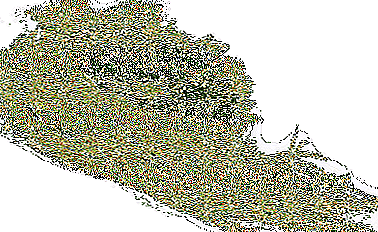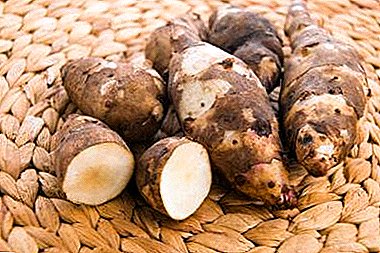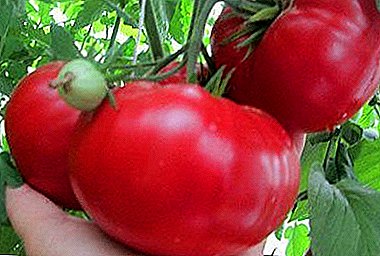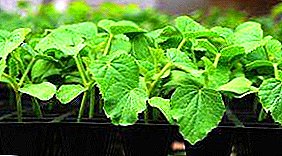
Dill is a common annual herb of the umbrella family. Widely used in cooking and traditional medicine. This uses all parts of the plant.
Dill root branchy, straight. It is considered the most useful part of the plant, because, in addition to its healing properties, it has a high nutritional value. This is what the article will be about.
The article describes how to properly apply the root of dill in various diseases, it tells how it benefits the body.
Useful and healing properties
The active use of dill root in cooking and treating diseases is associated with its pleasant taste, unique healing properties and the wide availability of the plant.
Chemical composition

Dill root has a rich nutrient composition, including vitamins, micro and macronutrients.
The nutritional value:
- proteins - 2.7 g;
- fat 0.5 gr;
- carbohydrates - 6.3 g;
- food fibers - 2,8 gr;
- organic acids - 0.1 g;
- water - 85.5 g;
- saturated fatty acids - 0.1 g;
- unsaturated fatty acids - 0.1 g;
- mono - and disaccharides - 6.2 g;
- starch - 0.1 g;
- ash - 2.3 gr.
Vitamins:
- retinol - 750 mcg;
- Vitamin B1 - 0.03 mg;
- vitamin B2 - 0.1 mg;
- Pantothenic acid - 0.3 mg;
- Vitamin B6 - 0.2 mg;
- folic acid - 27 mcg;
- ascorbic acid - 100 mg;
- tocopherol - 1.7 mg;
- nicotinic acid - 0.6 mg;
- beta carotene - 4.5 mg.
Macronutrients:
- calcium - 223 mg;
- magnesium - 70 mg;
- sodium, 43 mg;
- potassium - 335 mg;
- phosphorus - 93 mg.
Trace elements:
- iron 1.6 mg;
- Zinc - 0.91 mg;
- copper - 146 mcg;
- manganese - 1, 264 mg.
Calorie content: 40 kcal per 100 g of product.
Indications for use

The range of use of plants in traditional medicine is quite wide. Dill root is used in the following cases:
- pathology of the heart and blood vessels, hypertension;
- liver and kidney disease;
- cough, respiratory viral infections;
- digestive problems, lack of appetite;
- treatment of injuries and abrasions;
- conjunctivitis;
- increase milk production in lactating women.
Usually decoction of the root is used until the disappearance of unpleasant symptoms. Usually the course lasts from 2 to 4 weeks.
Contraindications
As with every medicine, dill root has contraindications:
- Pancreatitis. When inflammation of the pancreas can cause exacerbation of the disease.
- Hypotension. A decoction of the roots lowers blood pressure.
- Lack of nutrients and minerals. Dill root - a diuretic, because it can cause a shortage of essential trace elements.
- Individual intolerance.
Use caution fennel root during pregnancy. When used in large quantities, it can cause miscarriage or premature birth.
What to do with the product to improve health?
From the root of dill is made infusion, which has useful properties:
- possesses hypotensive action;
- dilates blood vessels;
- normalizes digestion;
- is a diuretic;
- has a beneficial effect on the heart;
- stimulates lactation in lactating women.
With hypertension

Due to the active vasodilator action, dill root has a beneficial effect on the condition of the heart and blood vessels. To normalize blood pressure use infusion.
- For its preparation, 2 tablespoons of the chopped dill roots is poured with a glass of boiling water.
- Close the lid and languish for a quarter of an hour in a water bath.
- Cooled infusion filter.
Take ¼ cup three times a day half an hour before meals.
For kidney
Infusion of dill roots has a diuretic and antibacterial effect.
- To chopped roots (about 2 tablespoons) add 200 ml of hot water and cook for 15 minutes in a water bath.
- Then cool and filter.
Prepared universal infusion consumed 6 times a day, 50 ml (half cup as a diuretic).
For liver
Dill decoction has choleretic effect. Helps with inflammation and liver obesity.
- Finely chopped roots in the number of tablespoons pour water.
- Boil for 10 minutes and allow to cool.
Use the decoction in three doses of 100 ml before or after meals.
From cold
Taking the decoction of dill root helps to quickly cope with a viral infection and eases coughing. In addition to the universal method of preparation, which is described at the beginning of the section, you can use another option in the treatment of colds.
- 1 tablespoon of washed and milled roots is placed in an enamel container.
- Add boiling water and put on low heat.
- Boil for 10 minutes, then allow to stand until cool.
Take 3 times a day before meals for half a glass.
For the nervous system

Dill has a mild sedative effect, helps with stress and overloads. For treatment, take 20-30 ml of decoction of the roots 3 times a day for half an hour before meals.
To prepare the broth, you need:
- Chop the roots and pour boiling water (take the ingredients in a ratio of 1 tablespoon of dill to 1 cup of water).
- The resulting mixture is heated over low heat for 10 minutes and allowed to stand, and then filtered.
Injuries, wounds
Thanks to a pronounced antiseptic effect, rhizome can be used externally in the form of an ointment for the treatment of wounds and injuries. The ointment is made from pork fat and dill roots, crushed into powder, in a ratio of 1: 3.
For eye inflammation
In the treatment of conjunctivitis, it is effective to apply lotions with decoction of dill roots. To prepare, it will take 1 tablespoon of the ground roots to fill with hot water and boil for 10 minutes and then cool.
A cotton pad is dipped in the prepared broth, lightly squeezed and placed on the affected eye. Compress can be held for about 10 minutes.
With reduced appetite
- Two tablespoons of finely chopped roots pour a glass of boiling water and cook for a quarter of an hour in a water bath.
- After cooling, filter.
The course of reception lasts, if necessary, up to two weeks.
For digestion
To improve digestion, eliminate flatulence using infusion of dill.
- The crushed roots are combined with a glass of hot water and kept for 15 minutes in a water bath.
- Then let stand and filter.
Take three times a day for an hour before meals, 80 ml.
Where to buy and how much?
 Despite all the beneficial properties dill root is not easy to find on sale. This is due to the fact that the terrestrial parts of the plant are used more often, respectively, and the demand for them is higher. Because purchase rhizome in the store separately will not work.
Despite all the beneficial properties dill root is not easy to find on sale. This is due to the fact that the terrestrial parts of the plant are used more often, respectively, and the demand for them is higher. Because purchase rhizome in the store separately will not work.
However, on the shelves of the vegetable departments quite often greens are found in bunches - look for the option where the roots are stored. On average, the cost of one bundle varies from 30 to 50 rubles, depending on the store and the time of year.
It is easy to buy dill root in farmers' markets in late spring and summer or even old women selling vegetables from their garden. And the easiest way is to grow dill by yourself: it is unpretentious in care, it is cold-resistant and can please with fresh greens even on the windowsill of a city apartment.
How to store?
Fresh dill root is stored for long.
If necessary, prepare it for the winter, you can use two methods:
- Frost. The roots are cut into small pieces, put in sealed containers or bags for freezing and put into the freezer. This method is more often used for culinary purposes.
- Drying. The roots are cut in small slices and dried in the oven at a temperature of not more than 50 degrees and a constant flow of air or in a special dryer for vegetables. The resulting raw materials can be ground to powder and stored in glass jars in a dry, dark place.
Before harvesting, the roots are thoroughly washed and dried. Thus, dill is stored all winter.
Dill root has many beneficial properties., making its use effective in the treatment of a number of diseases. However, it should be remembered that its use, as well as the use of any drug, should be treated with caution. Vegetable origin of raw materials is not a guarantee of its safety. Before starting treatment it is recommended to consult a doctor.












